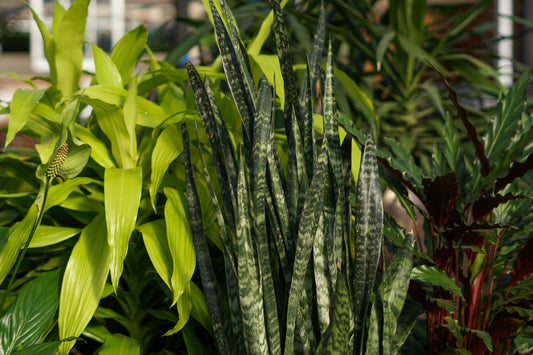Hello.
My name is Nina and I have the good fortune to be Molbak’s houseplant buyer. I’m passionate about living close to nature through houseplants so this buying job is a dream come true. I have been a serious plant collector since 2020, when the pandemic changed our lives, and my love of travel was put on hold. Today, about 100 plants are squeezed into my 800 square foot home and I love every one of them.
As a buyer, I have expanded Molbak’s Rare & Unusual Houseplant selection and focused on unique indoor plants. It’s been a source of joy to see others inspired by the plants I select, and I am proud to say that we have the largest selection of houseplants in the Pacific Northwest.
It is hard for me to pick just one but here are some of my all-time favorites:
Dieffenbachia ‘Crocodile’

- The beautiful coloring and rigid center of the leaves resemble a crocodile bite.
- Unique in how upright it grows, ‘Crocodile’ is a perfect statement plant for a smaller space.
- EASY care – Dieffenbachia in general are some of the easiest indoor plants to care for. They don’t need to be watered as frequently as many other foliage plants, are happiest out of direct sunlight and typically do fine in medium-low light spots
- Dieffenbachia are the most underrated indoor plants, in my opinion – there are a ton of varieties, lots of beautiful leaf patterns and variegation, and they are very affordable. Some other favorite varieties that I like to bring in are ‘Camouflage’ and ‘Puerto Rico variegated.’
Epipremnum amplissimum

- A unique Epipremnum (pothos) variety with long, narrow silvery leaves.
- Climbing/vining – I have mine trailing because I love the combination of a vining plant and a pot with a funky pattern or bold color.
- Epipremnum are typically very easy to care for.
Philodendron ‘Florida Ghost/Mint’

- My ‘Mint’ version has brought me more excitement than probably any other plant I have. Every leaf it has put out has been drastically different, from dark green and lightly minty to almost completely white. My favorite part is the BRIGHT red/pink petioles.
- I recommend a heavily amended well-draining soil mix, especially if you’re prone to over-watering (I am!).
- The more light they get, the lighter/more variegated the new leaves tend to be. I move mine around after every leaf to keep the contrast in color between leaves (not sure if it works that way, but it doesn’t hurt!)
- ‘Ghost’ leaves (almost completely white) are beautiful, but they will begin to turn brown and die off a little faster than the greener leaves. It’s completely normal, my advice is just to appreciate them and enjoy them while they last (which is still quite a while!).
Anthurium clarinervium

- One of my favorite Anthuriums – heart-shaped rigid, velvet leaves with beautiful white veins
- Anthurium leaves are really fun to watch, because instead of unfurling at their mature size, they start out really small and you get to actually watch the leaf itself expand/grow over time. It’s hard not to take pictures of new leaves progress every day like a proud parent
- Anthuriums are notorious for being more difficult to care for, but I’ve found this variety to be quite easy. Give it time to acclimate to the conditions in your house and then try to keep it in the same area (they’re dramatic about being moved). They do enjoy more humid environments, so keeping it in a plant cabinet or in an area with several other plants is helpful.
- They will occasionally bloom. To encourage more leaves simply cut off the bloom. Their blooms will last a LONG time, and you typically won’t get any new leaves while it’s in bloom because the plant is putting all its’ energy into the bloom.
Amydrium zippelianum

- Another lanky/spindly plant that I’m obsessed with – they look incredible when they’re mature!
- They’re a little high maintenance and require more attention than a lot of other indoor plants, but they’re VERY communicative when they need your attention. When it’s time to water, the leaves will get really droopy and I always worry that I’ve neglected mine too long, but they bounce right back once they’ve been watered. Try not to let this plant dry out completely between waterings, and amend your soil with something that retains water, like coco coir.
- This plant tends to send out runners (long lengths of stem without leaves), which can require some patience and makes them a slower-growing plant. You can chop the runners off to encourage new growth (and you can propagate the nodes you cut off if you want to), but I like to leave mine as they are and will coil them around the inside of the pot and loosely pin them to the surface of the soil with a bobby pin to encourage the nodes to root.
Come and see us at Molbak’s. We have a great selection of plants and experts on hand to help you solve your plant woes or inspire you to add something new to your collection. Be sure to follow our Houseplant department (@molbaks_houseplants) on Instagram for care tips, new arrivals, and indoor jungle inspo.



